






Introduction to solar energetic particles
Solar Energetic Particle (SEP)
events detected in interplanetary medium consist of electrons, protons, and heavier ions up to Fe (and higher) with energies from dozen of keVs to the GeV range. SEP events result from the acceleration of particles either by solar flares, by interplanetary shocks driven by Coronal Mass ejections (CMEs) or by shocks associated with corotating interactive regions. Accelerated particles then propagate through the heliosphere, spiraling along the interplanetary magnetic field (IMF). By studying SEP events, one can obtain information on the physical mechanisms of particle acceleration, the eruption site conditions and properties of the space environment sampled by these particles during their trip to the observer's location. The understanding of the mechanisms associated with the generation, acceleration, and propagation of solar energetic particles is far from being complete due to its inherent three-dimensional nature, the lack of widely spatially distributed in situ observations, and the complex nature of the underlying physical processes.
SEP events are observed as flux increases from a background level to several orders of magnitude above the background, lasting from a few hours to several days. The onset of these particle enhancements is usually associated with solar activity phenomena indicators (solar proxies). There are various definitions of SEP events depending on the energy level, the flux threshold, the lagtime (the time after the flux drops below the threshold), the sampling time or the minimum event characteristics (e.g. lowest fluence or lowest peak flux).
As a consequence, there are different
SEP event lists available in the literature.
SEP events are of particular interest and importance for space missions, because they pose a health risk to humans and a serious radiation hazard for spacecraft.
Protons are the predominant ion species measured in large events and the primary radiation hazard.
The radiation effects caused by SEP events are
single event effects or
total dose effects.
Classification of SEP events
A conventional classification among the community [1] distinguishes two major classes of SEP events: impulsive and gradual. This classification has been supported by the systematic differences observed in the intensity profiles, the elemental abundance compositions, and the time scales of the associated soft X-ray events.
Impulsive events show short-duration soft X-ray emission and are associated with flare acceleration processes. They are characterized by small interplanetary ion intensities, a high electron to proton intensity ratio, enhanced abundances of heavy elements, and enhancements of 3He relative to 4He by up to a factor of 104.
Gradual events show long-duration soft X-ray emission and are associated with interplanetary shocks, driven by CMEs. They are characterized by large interplanetary ion intensities, small electron to proton ratios, on average elemental abundances and ionic charge states in consistency with solar coronal abundances and temperatures.
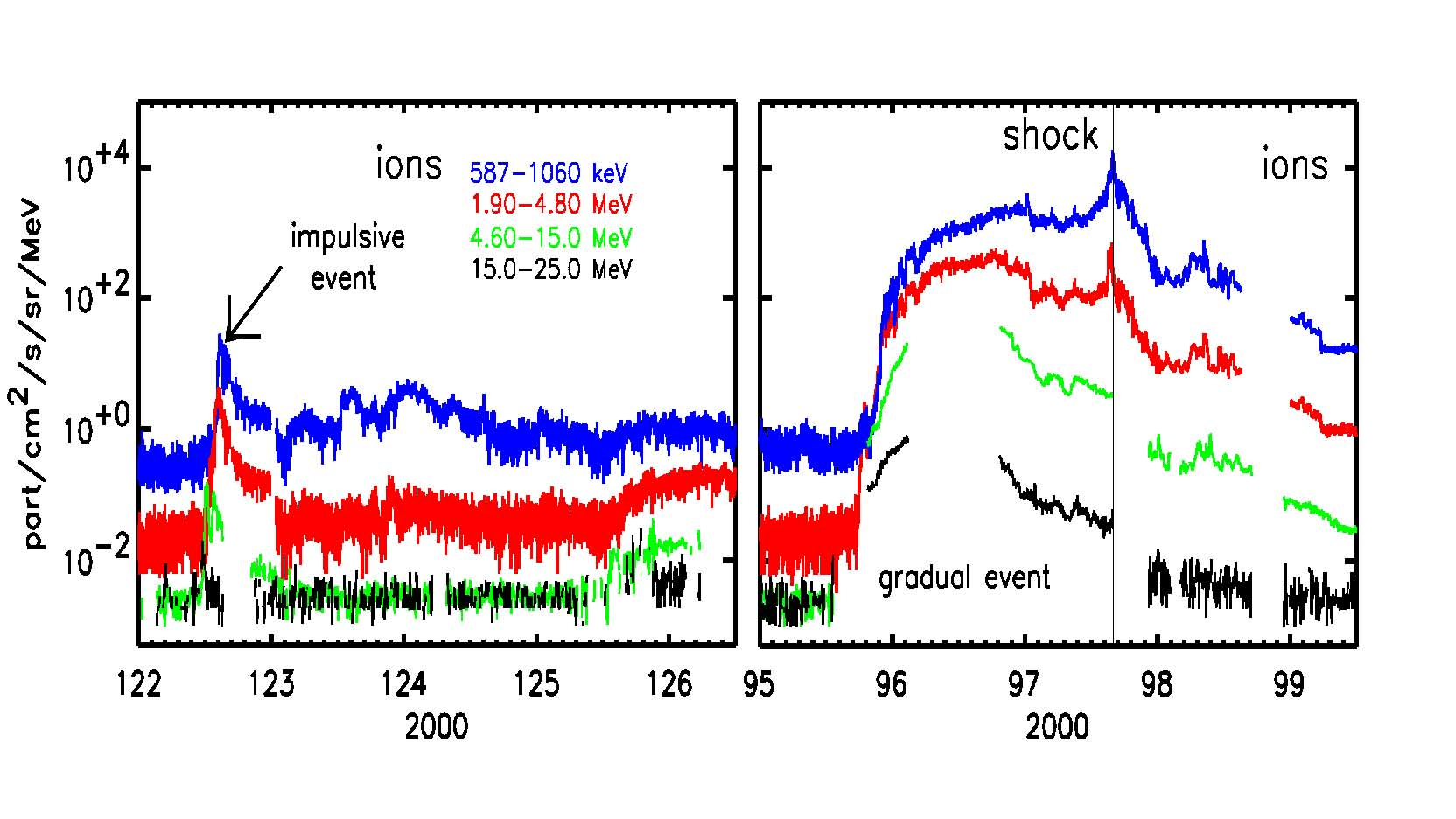
|
|
Figure 1. Intensity-time profiles of protons for
an impulsive (left) and a gradual (right) SEP event, as measured by
ACE/EPAM and IMP-8/CPME (two lower high energy channels) (from [2]).
|
Impulsive events are about a hundred times more frequent than gradual events at the maximum of solar cycle, but they have typical durations of the order of hours and they are less intense than gradual events. Therefore, impulsive events have weak space weather effects in terms of total fluence and peak flux intensities.
The usage of this dichotomic classification has been critically reviewed by [3]. Charge state and abundance measurements gathered during the last two solar cycles, together with the fact that intense electron events are also associated with CMEs have blurred the difference between the two types of SEP events [4] and confirm that there are several discrete mechanisms that involve mixed accelerating processes [2, 4]. Despite the oversimplification that this classification represents, it is still frequently used.
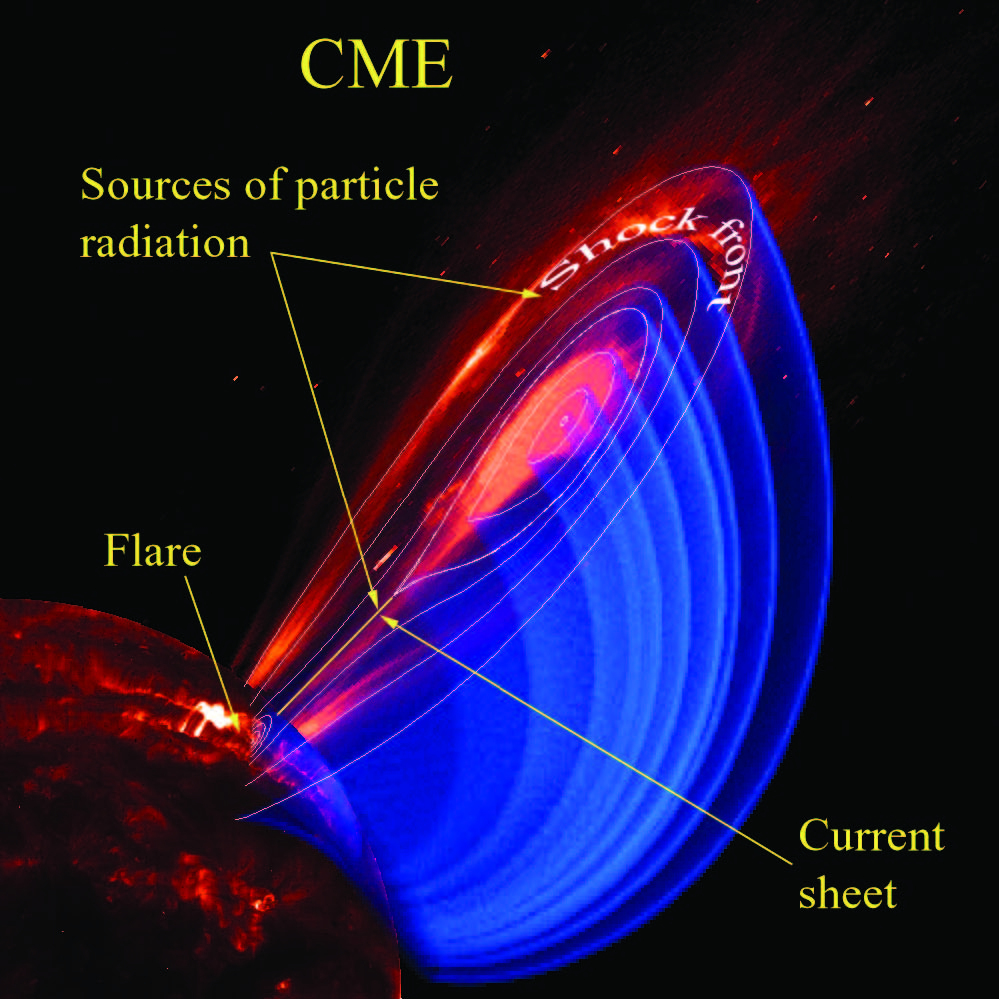
|
|
Figure 2. Composite illustration of a generic
coronal mass ejection (CME) and flare system related to the production
of energetic particles. Solar energetic particles are likely produced
from the flare and current sheet and from the shock front near the
leading edge in fast CMEs. (Adapted from Kohl et al., 2006. Copyright
2006, Springer. Reproduced with permission of Springer Science and
Business Media.) (picked up from Space Radiation Hazards and the Vision
for Space Exploration: Report of a Workshop. Ad Hoc Committee on the
Solar System Radiation Environment and NASA’s Vision for Space
Exploration: A Workshop, National Research Council.
ISBN: 0-309-66291-5.
http://www.nap.edu/catalog/11760.html)
|
Typical profile of a gradual proton event
The typical time profile of the particle flux of an isolated gradual proton event has the idealized form shown in Fig. 1. The general properties are: (a) a propagation delay between the initial acceleration and the onset of particle flux increase; (b) an initially anisotropic flux favoring a specific direction from the Sun which gradually becomes near isotropic; (c) a rapid increase of the intensity to a local maximum; and (d) a slow decay to the background level. The profile may include a short period of flux enhancement as a fast IP shock passes over the observer. This intensity peak is called
energetic storm particle (ESP) component and its presence means that the shock is still actively accelerating particles [5, 6]. Depending on the energy of the particles and varying from event to event, the first maximum may be not observed because the contribution of the shock-accelerated particle to the particle intensity is very large and time-extended. In fact, the lower the energy considered, the larger the ESP component is. This means that for energies smaller than a few MeVs (the precise value is different for each SEP event), there is no maximum in the prompt phase of the event.
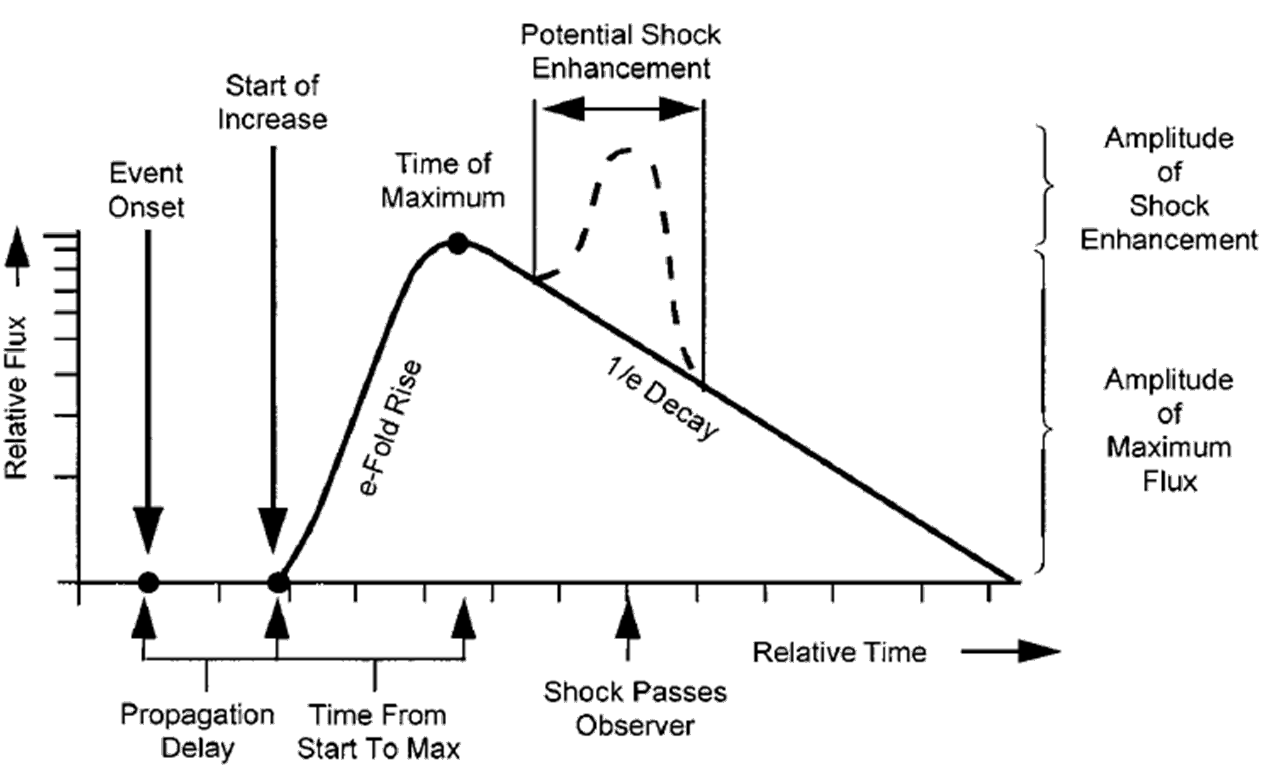
|
|
Figure 3. Idealized profile of a proton event [6].
|
Magnetic connection to the observer
The intensity-time profiles of SEP events result from the evolution of the particle population in a set of flux tubes that sweep over the observer. The motion of charged energetic particles from their source to the observer is constrained by the Parker spiral pattern of the IMF. This causes an asymmetry in the intensity-time profiles depending upon the observer's longitude (and latitude). For typical solar wind conditions, good magnetic connection to an observer at Earth for an impulsive event is approximately W50-W70. However, given the various uncertainties of the IMF including the solar wind speed variations, impulsive SEP events observed at near geospace are generally limited to within a 30° longitude band about the footprint of the nominal field line magnetically connected to the flaring region. Gradual SEP events, however, are observed wide-spread over a broad range of solar longitudes—even up to 180° in extreme cases—regardless of the associated solar flare location. For a fast CME, particle acceleration begins as the shock forms in the solar corona and continues as the shock moves out into the IP medium. The expanding shock crosses other IMF lines, accelerating particles which flow outwards over an extremely wide front. The most efficient acceleration takes place near the nose of the shock, ahead of the CME.
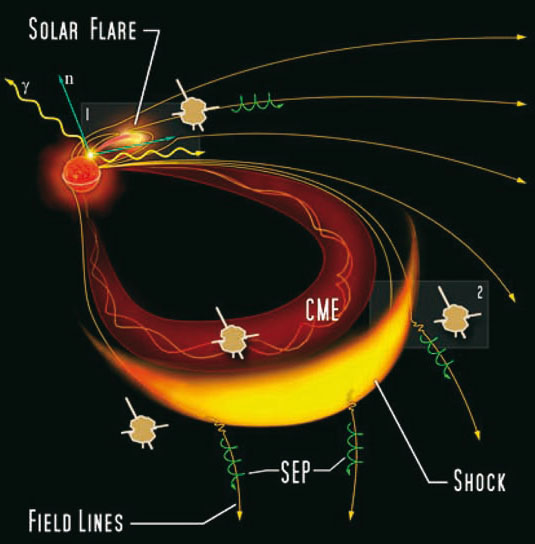
|
|
Figure 4. Cartoon showing that spacecraft located
at different vantage points magnetically connect back to different the
parts of the interplanetary shock, producing different types of SEP
intensity profiles (NASA/TM—2006–214137. Solar Sentinels: Report of the
Science and Technology Definition Team, 2006).
|
As a consequence, the associated intensity profiles present a wide variety of spatial and temporal characteristics depending on multiple parameters such as:
- the released energy,
- the existence and characteristics of the shock and
its efficiency to accelerate particles,
- the transport processes of the accelerated particles,
- the presence of seed particle populations in IP space to be accelerated,
- the local structure of the ambient solar wind, and
- the heliolongitude of the source region with respect to the spacecraft location.
The point of the shock front at which successive magnetic field lines connect the observer is usually termed as the cobpoint (connecting with the observer point) [7]. Various general forms of SEP event intensity profiles can be interpreted by following the clockwise motion of the cobpoint.
- SEP intensity profiles from the western hemisphere present rapid rises to their intensity maximum because the cobpoint is close to the nose of the shock near the Sun. The rapid increment is followed by a gradual decay as the cobpoint moves toward the eastern flank of the shock where the shock is weaker (see left-hand plot of Fig. 5).
- SEPs from the eastern hemisphere get magnetically connected with the geospace a few hours prior to the arrival of the shock front, as the cobpoint moves from the weak western flank to the central parts of the shock (see right-hand plot of Fig. 5).
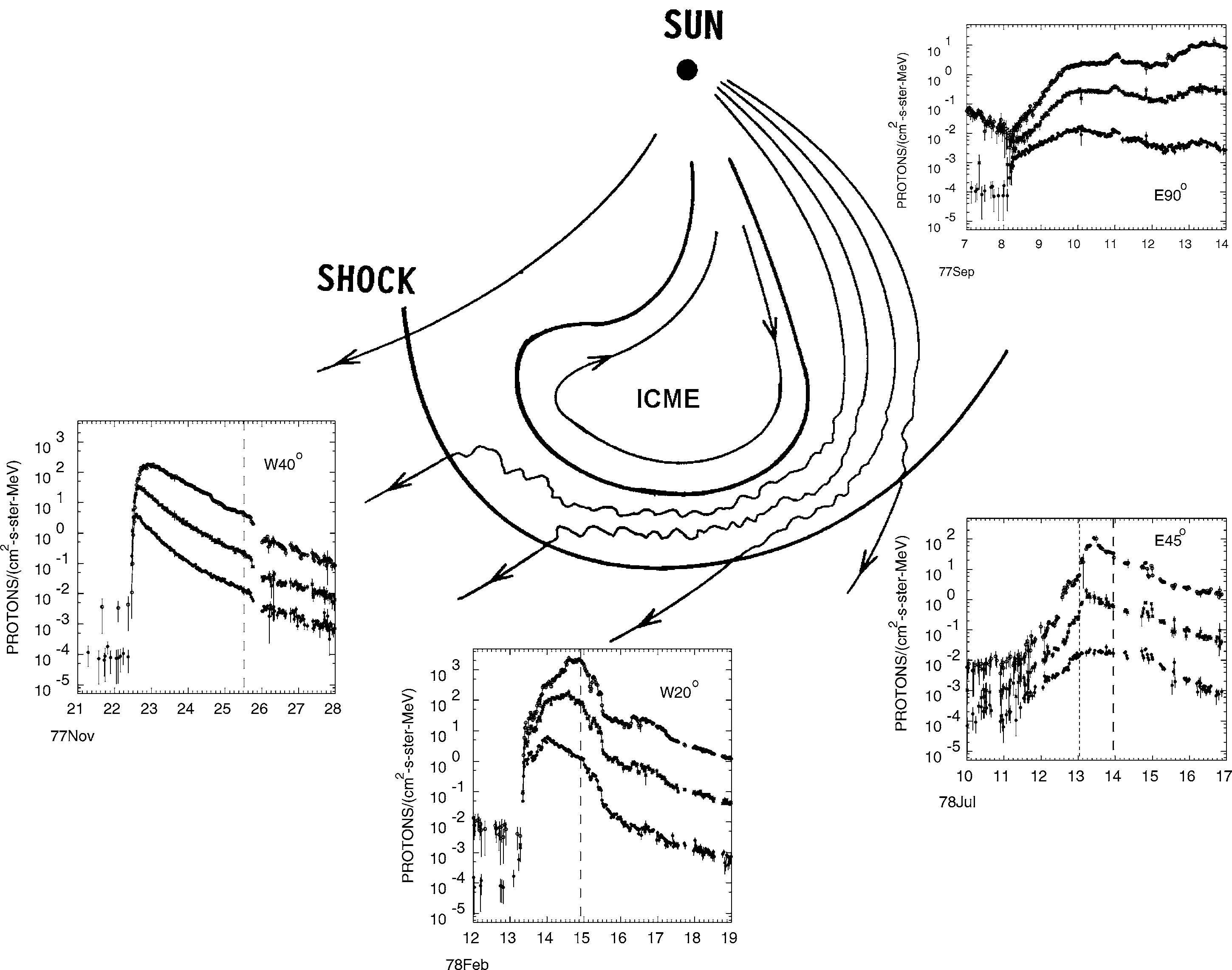
|
|
Figure 5. Intensity-time profiles for three
proton energies (5, 15 and 30 MeV) are shown for an observer viewing an
interplanetary CME-driven shock (ICME) from four different longitudes.
Particle intensity profiles are organized by the longitude of the
associated solar event. Dashed lines indicate the passage of shocks
(from [4]).
|
Radial dependence of particle fluxes and fluences
The radial dependence of SEP fluxes and fluences deviates from the inverse square law attributed to the case of assuming a fixed source of accelerated particles at the Sun and diffusive transport for particles [8]. The variation with radial distances changes from event to event mainly due to the varying conditions at the front of the shock, when considered as a particle accelerator. An observational study by [9] has shown that the efficiency of particle acceleration at the front of interplanetary shocks depends more on the longitudinal (angular) separation between the observer's cobpoint with respect to the nose of the expanding shock than with respect to the radial distance of the shock from the Sun.
Modelling of SEP events using the shock-and-particle developed by [10], applied at different radial distances [11] fully agree with this observational result. As a consequence, at present, there is no standard scaling relation and the values of the indices for radial dependence may vary from R-4 to R-3 for proton fluxes above 1 AU and from R-3 to R-2 for proton fluxes below 1 AU (and for proton fluences as well) depending on the model and the effects considered.
Energy spectra
There are several function forms that have been used to describe the energy spectra of gradual and impulsive SEP at various energy ranges. Spectral forms that usually fit successfully individual events include, among others, the simple power law and the double power law. The spectra of gradual events and its variance in time are determined by the diffusion and the convection mechanisms associated with the shock propagation. The knee (or roll over energy) in the double power law separates the spectra in two energy regimes and is attributed to the MHD wave activity at the upstream of the shock associated to gradual events. The energy value of the knee depends on the strength and the intensity of the developed wave turbulence. Above this critical value, the number of particles in the energy distribution is not sufficient to sustain the self-generated wave turbulence [12].
SEPEM and SEPs
The application server of SEPEM provides the following utilities for the analysis of SEP events:
- Cleaned and raw data from 1973 up to 2013
- Generation of SEP event list defined by threshold and lagtime values set by the SEPEM user
- Calculation of flux and fluence spectra for selected events
- Standard and new radiation environment statistical tools
- The Solar Particle Engineering Code, SOLPENCO2
- Radiation effect tools based on GEANT4 platform
References
[1] D.V. Reames, Astrophysical J. 571, L63 (2002).
[2] A. J. Tylka and M. A. Lee, ApJ 646, 1319 (2006).
[3] E.W. Cliver, and H.V. Cane, EOS Trans AGU , 83, 61 (2002).
[4] H. V. Cane, and D. Lario, Space Sci. Rev. 123, 45 (2006).
[5] D. V. Reames, Space Science Reviews, 90, 413 (1999).
[6] R. Turner, IEEE Trans. Plasma Sci. 28 (6), 2103 (2000).
[7] A. M. Heras, B. Sanahuja, D. Lario. et al, ApJ 445, 497 (1995).
[8] D.C. Hamilton, M. Mason, and F.B. McDonald, in 21st ICRC Vol. 5, 237-240 (1990).
[9] D. Lario, M.-B. Kallenrode, R. B. Decker et al ApJ 653, 1531 (2006).
[10] D. Lario, B. Sanahuja, and A.M. Heras, ApJ, 509, 415 (1998).
[11] A. Aran, B. Sanahuja, and D. Lario, Annales Geophysicae, 23, 3047 (2005).
[12] A. J. Tylka, P. R. Boberg, R. E. McGuire et al, AIP Conf. Proc. 528, 147 (2000).
Last modified: 02.09.2013 by DH











